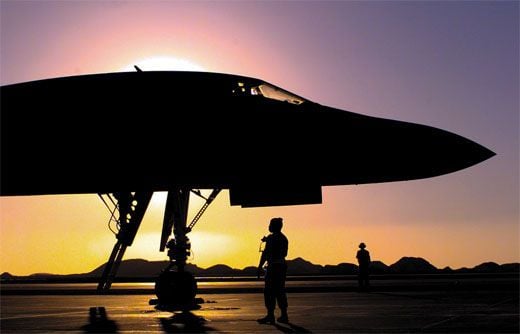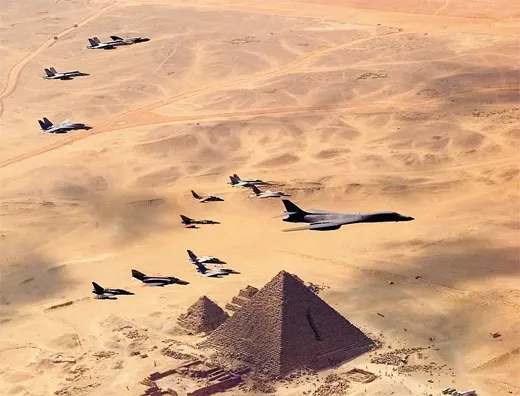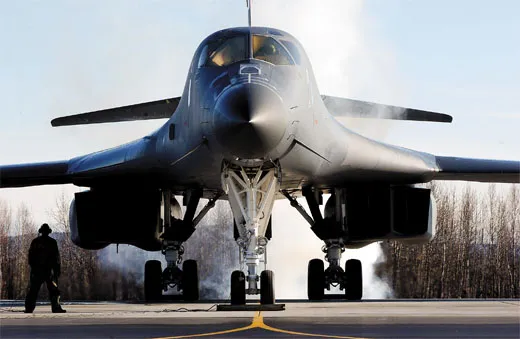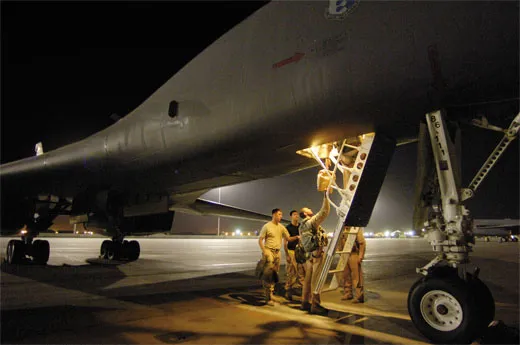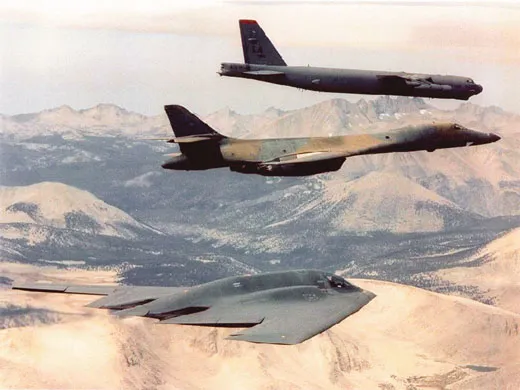The Bone is Back
Too trouble-prone for nuclear alert and sidelined in the first Gulf War, the B-1 is today the busiest bomber in the fleet.
/https://tf-cmsv2-smithsonianmag-media.s3.amazonaws.com/filer/bone-0308-631.jpg)
It's one o'clock in the morning on December 17, 1998, a cool crystalline night at Thumrait Air Base in the Persian Gulf sultanate of Oman. Two Rockwell B-1B bombers idle on Runway 17. Cleared for takeoff, the first jet begins to roll, its afterburners washing the rocky desert landscape in a faint orange glow. Quickly gathering speed, the Lancer lifts off the runway and banks into a sharp turn to the right, heading west. Forty-five seconds later, the second B-1B follows. The two jets join up in a loose formation and turn north into the starry blackness.
For the B-1, this is an historic moment: the long anticipated first combat mission of the complex, expensive, and oft-maligned bomber delivered to the Air Force 13 years earlier. Born amid controversy in the 1960s, twice canceled, and plagued early by technical problems, the B-1 had seemingly gotten lost in the shadows—caught between the Boeing B-52, the iconic bomber of the past, and the Northrop B-2, the stealthy bomber of the future. In 1990, the B-1 had suffered the ultimate humiliation: staying Stateside during the first Gulf War, while the plodding, antique B-52s answered the call to duty.
But now, in Operation Desert Fox, the four-day 1998 air campaign against Iraqi president Saddam Hussein, the B-1 was finally getting a chance to prove its worth. "Failure was not an option that night," recalls Lieutenant Colonel Gordon Greaney, a back-seat weapon systems operator on the trail aircraft. "We all had very big chips on our shoulders after the Gulf War." The B-1s were to take out the main barracks of Saddam's elite Republican Guard at Al Kut, 100 miles southeast of Baghdad. The two big jets would be escorted by a dozen carrier-based fighters and an EA-6B Prowler.
Joining up with the Navy aircraft, the two B-1s crossed the Iraqi border at 26,000 feet and 550 mph. They navigated around an Iraqi SA-2 surface-to-air-missile site, but two more sites, equipped with the more dangerous SA-3 missiles, awaited near Al Kut. Greaney, chewing tobacco and occasionally spitting to the side of his dangling oxygen mask, monitored the SA-3 tracking radars on his instrument panel displays. He watched as the SAM radars flicked on briefly, then shut down, the operators apparently fearful of the radar-homing missiles carried by the EA-6B. He breathed a sigh of relief: No SAMs tonight.
Approaching the target, the B-1 crews watched as orange streaks of anti-aircraft artillery fire arced far below them. Seven miles out from Al Kut, Greaney's B-1, nicknamed "Watchdog," released its load of 64 500-pound "dumb" bombs. The drop took only five seconds; the B-1 immediately racked into a steep 3-G right bank and headed back toward Thumrait.
It hadn't been a perfect mission—sand in the bomb release mechanism had caused 20 bombs to hang up—but all in all, things had gone smoothly. After landing around 6:30 a.m., with the sun just rising off the left wing, Greaney crawled into his tent to sleep, exhausted and exhilarated. Not until the next night did he see the satellite photo that showed a tight cluster of marks centered on the barracks, with nearly a dozen direct hits. In the close, competitive world of bomber crews, Greaney and his mates had earned bragging rights.
For the B-1, the destruction of the Republican Guard barracks that night was the first step back toward respectability. (Two other Desert Fox missions were also successful.) Subsequent combat in Kosovo, Afghanistan, and Iraq confirmed its comeback. And last year, the B-1's tale of redemption reached an unlikely zero-to-hero ending: In Southwest Asia, the former Rodney Dangerfield of warplanes became the bomber of choice. Since April 2006, the fancy $2 billion stealth bombers have sat meekly in climate-controlled Missouri hangars or deployed to Guam for training exercises, and the B-52s have rested their weary combat wings Stateside, while B-1s have been flying almost daily against the Taliban. Tony Straw, a B-1 pilot with the Seventh Bomb Wing at Dyess Air Force Base in Texas, says proudly, "We're now in demand."
The B-1 was born in a time of stormy debate about strategic bombing philosophy. Manned bombers or intercontinental ballistic missiles? Penetrate or stand off? High altitude or low? The first casualty of the debate was also the Air Force's first stab at a B-52 replacement: the XB-70, a high-altitude Mach 3 marvel. Its radar cross-section and infrared signature would have made the aircraft an easy target for a new generation of Soviet missiles, however, and in 1961, Air Force planners turned their focus to a low-level, under-the-radar bomber. Numerous design studies ensued, with acronyms like SLAB, ERSA, LAMP, AMPSS, and finally, in 1964, AMSA, for Advanced Manned Strategic Aircraft. (Wags said that it stood for "America's Most Studied Aircraft.") But Secretary of Defense Robert McNamara, a believer in ballistic missiles rather than manned bombers, limited AMSA funding to a trickle. Worried that the B-52s would start suffering structural failures before a new bomber could replace them, the Air Force ordered an interim solution: the General Dynamics FB-111, which presaged many features of the bomber-to-come.
The new Nixon administration, however, revived the strategic bomber design, renamed it the B-1, and selected North American Rockwell to build it. The bomber on Rockwell's drawing board was in every way different from a B-52: a highly maneuverable Mach 2.2 low-level penetrator packed with advanced electronic countermeasures. Its mission: a terrain-hugging, under-the-radar nuclear attack on Moscow. And the B-1 looked like a weapon of mass destruction.
Its blended wing/body design and sinuous fuselage, shaped by the area rule, cut supersonic drag. The variable-geometry wing swept forward to 15 degrees for takeoff and landing, and back to a dart-like 67.5 degrees for supersonic dash. Its advances included terrain-following radar that enabled hands-off flying as low as 400 feet in any weather. To relieve the structural stresses of low-level turbulence on the long slim fuselage, small canard vanes below the cockpit automatically swiveled in response to gusts. To stay within center-of-gravity limits during wing sweep or weapons release, an automatic fuel-balancing system rapidly redistributed fuel among various tanks. A complex Defensive Avionics System was intended to detect and jam enemy radars.
The first prototype B-1A flew in 1974. Initial flight testing proceeded smoothly, but the B-1 continued to stir controversy on Capitol Hill, where critics sniped at its mission philosophy and constantly escalating cost. But its backers, led by right-wing firebrand Congressman Robert "B-1 Bob" Dornan, had managed to spread the B-1 subcontractor pork among many Congressional districts, a tactic that helped keep the project alive—until once again, political change rocked the B-1 program. Jimmy Carter, riding a post-Vietnam wave of skepticism about military power and citing budget concerns, scrapped the B-1 in 1977 in favor of the air-launched cruise missile (and, unbeknownst to the public, the stealth bomber, then in the early planning stages). But Carter did allow the four B-1A prototypes to continue testing.
Then came the presidency of the hawkish, free-spending Ronald Reagan, who revived the program. The new B-1B was beefier and could carry 50,000 more pounds of bombs and more fuel. A simplification of its engine inlets and a coating of radar-absorbing material would cut the jet's radar cross-section by 90 percent. The new inlets' design limited top speed to Mach 1.25, but it was decided that stealth (or at least semi-stealth) trumped speed.
Even though testing at Edwards Air Force Base in California was barely half finished, the B-1B stood its first nuclear alert in 1986, at Dyess Air Force Base. The rush to duty had predictable results: Even as their price tags were rising past $250 million each—the most expensive warplanes in history at that point—the B-1s were plagued with teething problems. Engines failed. Fuel leaked. The ballyhooed radar-jamming system had an unfortunate tendency to disrupt the B-1's own offensive radar, prompting the Armed Forces Journal to award the bomber the mortifying title "World's First Self-Jamming Bomber."
For all its initial problems, though, the B-1 was loved by its pilots, who affectionately call it the Bone (for B-One). "Never call it a Lancer," one Bone jockey cautioned me. With a fighter-style stick control, a relatively snappy 40-degrees-per-second roll rate, afterburners for instant kick-in-the-pants power, and a generous 3-G combat maneuvering limit, the Bone flies more like a fighter than a bomber. During a ride in the left seat of the B-1 flight simulator at Dyess, I got a feel for the Bone's agility. A firm yank on the stick triggered a roll rate that left me dizzy.
At airshows, B-1s have done barrel rolls, maneuvers unthinkable in a B-52 or B-2. (Search youtube.com for "Inverted Bone.") Major Dave Arnold, a Bone weapons systems officer with the Seventh Bomb Wing at Dyess, smugly points out that the stealth bomber, for all its vaunted electronic gizmos, is limited to sedate 25-degree banks and typically flies programmed missions almost entirely on autopilot.
And of course Bone jocks are the only U.S. bomber pilots who can bust the Mach. A favorite B-1 combat maneuver in the Gulf is the "show of force" run, a low-level, full-afterburner flyby to let the bad guys know who's in the neighborhood. "It breaks some eardrums," says Arnold. "And it's a great morale booster for our guys on the ground." Even at subsonic speeds, a Bone at full afterburner is almost certainly the world's loudest aircraft.
Unlike its pilots, however, the B-1's ground crews have a decidedly mixed opinion of their complex, finicky, and trouble-prone charge. "It's a love-hate relationship," concedes Staff Sergeant Walker Grant, a Seventh Bomb Wing crew chief at Dyess. "It's a high-performance vehicle. You're always tinkering. Comparing what it takes to keep a B-1 in the air to, say, a C-130 is like comparing a NASCAR racer to a go-cart." On many Bone missions, it's standard procedure to keep a second aircraft standing by with engines running in case the primary aircraft has some last-second problem.
To keep glitches to a minimum, Dyess ground crews ritually rub certain spots on their B-1s before each takeoff. (Just which spot depends on the particular aircraft.) "I've never been in a culture as superstitious as Bone crew chiefs," admits one of them. Even when everything's working, about 90 man-hours of labor are needed to prepare a B-1 for a training sortie—double the number for a B-52.
Because of its very shaky start and high maintenance, the Bone had very low combat readiness rates during its early years on nuclear alert. The nadir came in 1990, when a series of engine fires grounded the entire fleet just before Iraq invaded Kuwait. Bone pilots watched in envy and disgust as the B-52s flew off to the Gulf and glory.
But even had its engines been reliable and its defensive avionics working, the B-1 simply had no role to play in the first Iraq war. It was strictly a nuclear bomber, never intended for limited conventional wars, and not even capable of dropping conventional weapons. "It was horrible," recalls Colonel Jeff Taliaferro, a Bone pilot at the time who later flew the second Desert Fox mission. "Most of us had never been in combat, and we really wanted to go. When the nation's at war, you want to be part of it. The whole B-1 crew force was very disappointed."
After Desert Storm, the B-1 began the remarkable resurrection to its current status as America's go-to bomber. The first change in its fortunes was the 1991 collapse of the Soviet Union, which made the Bone's original nuclear deterrent role moot. Responding to the new strategic reality, the Air Force began to convert the B-1 fleet to carry conventional weapons. (The START arms reduction treaty later made the changeover mandatory.)
The following year, to compensate for the B-1's intensive maintenance requirements, the Air Force put 21 Bones on "attrition reserve," reducing the number of operational B-1s from 74 to 53. This allowed the available maintenance money, spare parts, and manpower to be spread over fewer aircraft. (Later, most of the "attrition-reserve" aircraft were retired altogether.) And a long-term program was initiated to improve the aircraft's computers, avionics, and weapons.
By the time of the 1998 Desert Fox operation, the upgrade was completed. Mission-capable rates had risen to the 70 percent range. And B-1 pilots, long steeped in SAC-style, low-level training, were now proficient in a whole new style of bombing: precision strikes with conventional weapons. This time when Saddam turned ornery, the Bones were ready.
The Desert Fox success earned the B-1 a big role in the Kosovo, Serbia conflict a few months later. Flying almost daily from Royal Air Force Base Fairford in England and using the same Mark 82 500-pounders and carpet-bombing tactic used in Desert Fox, a half-dozen B-1s dropped 20 percent of the total tonnage released by Allied air forces over Kosovo, while flying just two percent of the strike sorties. The B-1's first Kosovo mission, a raid on the Novi Sad oil refinery, was a baptism by fire; both aircraft were attacked by a SAM-6 missile. But the B-1s' new radar decoys, towed by the bombers on long cables, worked. The SAMs nailed the decoys, not the Bones.
Toward the end of the Kosovo campaign, the B-1B tried out a new Air Force tactic called time-sensitive targeting. Instead of bombing pre-arranged targets, the B-1 acted as a "roving linebacker," loitering over the battle area and awaiting target assignments from ground controllers. The B-1's speed, agility, payload capacity, and endurance made it ideal for this new kind of aerial warfare, enabling the Bone to strike multiple targets, on demand, during a single mission. Such a tactical role, of course, had never been envisioned by the B-1's designers. Yet here it was, an erstwhile intercontinental nuclear bomber acting like an F-16.
In Afghanistan in 2001, the B-1 finally put it all together. The new roving-linebacker role was a perfect fit for the Afghan theater, with its small mobile bands of enemies and ever-shifting battlefields. And the new 2,000-pound JDAM (Joint Direct Attack Munition) guided bomb, steered by GPS and accurate to within about 30 feet, proved to be the right answer for U.S. troops on the ground asking for close air support. JDAM-equipped B-1s destroyed the caves and training camps of the Taliban, with devastating effect. Air Force brass at the time credited the B-1 with a "very big part" in the rout.
By the time of the initial 2003 air campaign against Iraq, the B-1 and its JDAMs had mastered precision-strike-on-demand. During the first month of the war, a tag-team of 11 B-1s was over Iraq virtually 24/7, hitting a wide variety of targets within minutes of getting the call.
The Iraq war has since devolved into an urban civil and sectarian conflict in which aerial bombardment has little role, though on January 10 this year, two B-1s, joined by four F-16s, dropped 20 tons of bombs on what were believed to be militant hideouts and storehouses just south of Baghdad. And back in Afghanistan, the Bone has been raining JDAMs on a resurgent Taliban with such success that the B-2s and B-52s were sent home.
"In this war, at this time, the B-1 is the obvious choice," Colonel Jeffry Smith said last year, when he was commander of the 28th Bomb Wing, the B-1 unit currently deployed in the Middle East. "We're the one airframe that can carry all kinds of munitions, in large quantities, with a long loiter time. We can carry 500-pounders in the front bay, thousand-pounders in the middle, and 2,000-pounders in the back. You've always got the right bomb for the job, with a minimum of collateral damage. That's a great luxury for a commander." Recent civilian casualties in Afghanistan, however, are a grim reminder that even with highly accurate just-the-right-size bombs, targeting errors remain a serious problem.
Though it has found new esteem among Air Force brass, the B-1 may remain in the shadows of the B-52 and B-2, as far as the public is concerned. The Bone just missed a shot at stardom in 2003, during the initial strikes on Baghdad. Patrolling over western Iraq on April 7, the B-1B "Search and Destroy" got an urgent call from a nearby E-3 AWACS: a "high-priority leadership target" in Baghdad. It was The Big One, the AWACS operator reported. Translation: Saddam Hussein.
The jet banked sharply toward Baghdad and accelerated to Mach 0.9. Twelve minutes later, four 2,000-pound JDAMs slammed into the restaurant Saddam had been observed entering 47 minutes earlier. But the dictator had apparently decided to eat and run; by the time the bombs hit, he was gone.
Although the mission failed, it was a dramatic demonstration of the B-1's speed, range, flexibility, and targeting precision. And the Bone had not even flexed its muscles: A full-afterburner Mach 1.2 dash to the target would have gotten the bombs there six minutes sooner. Would those six minutes have made the difference? We'll never know.
